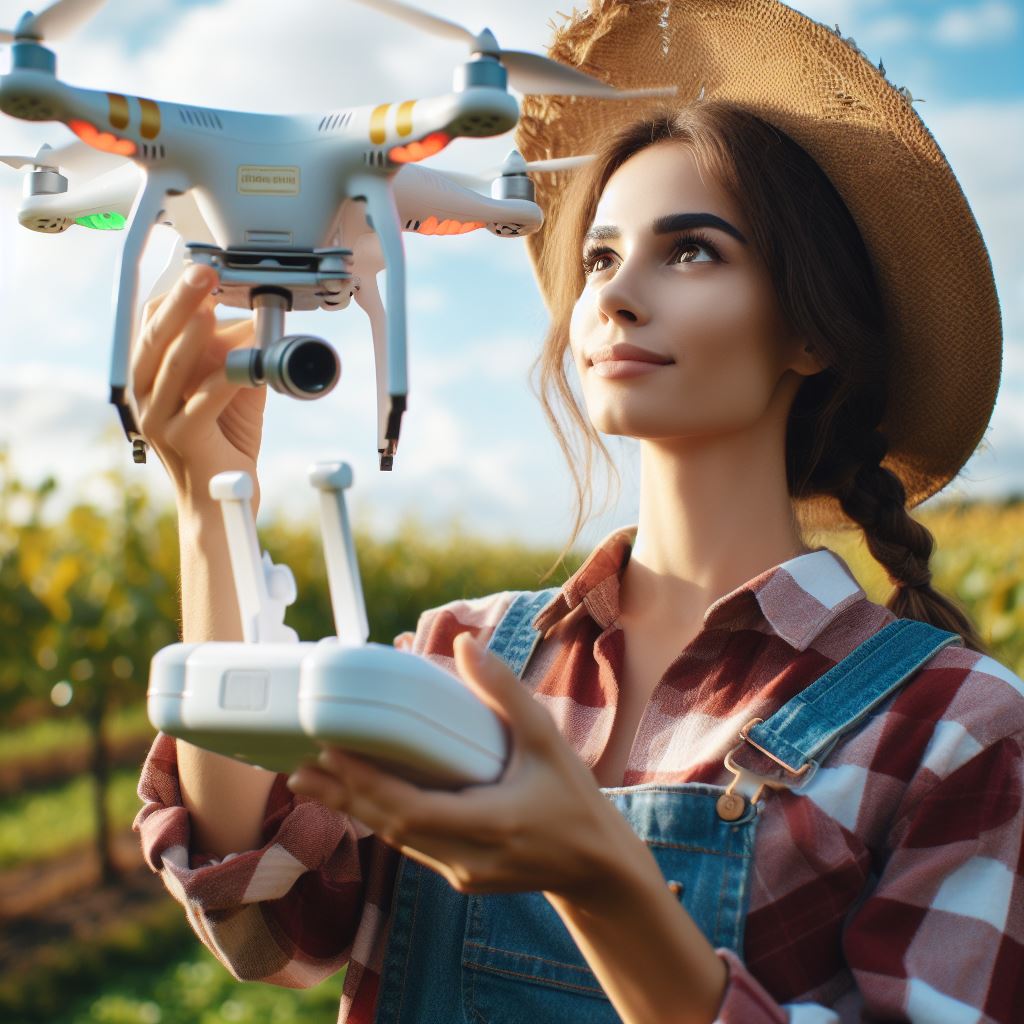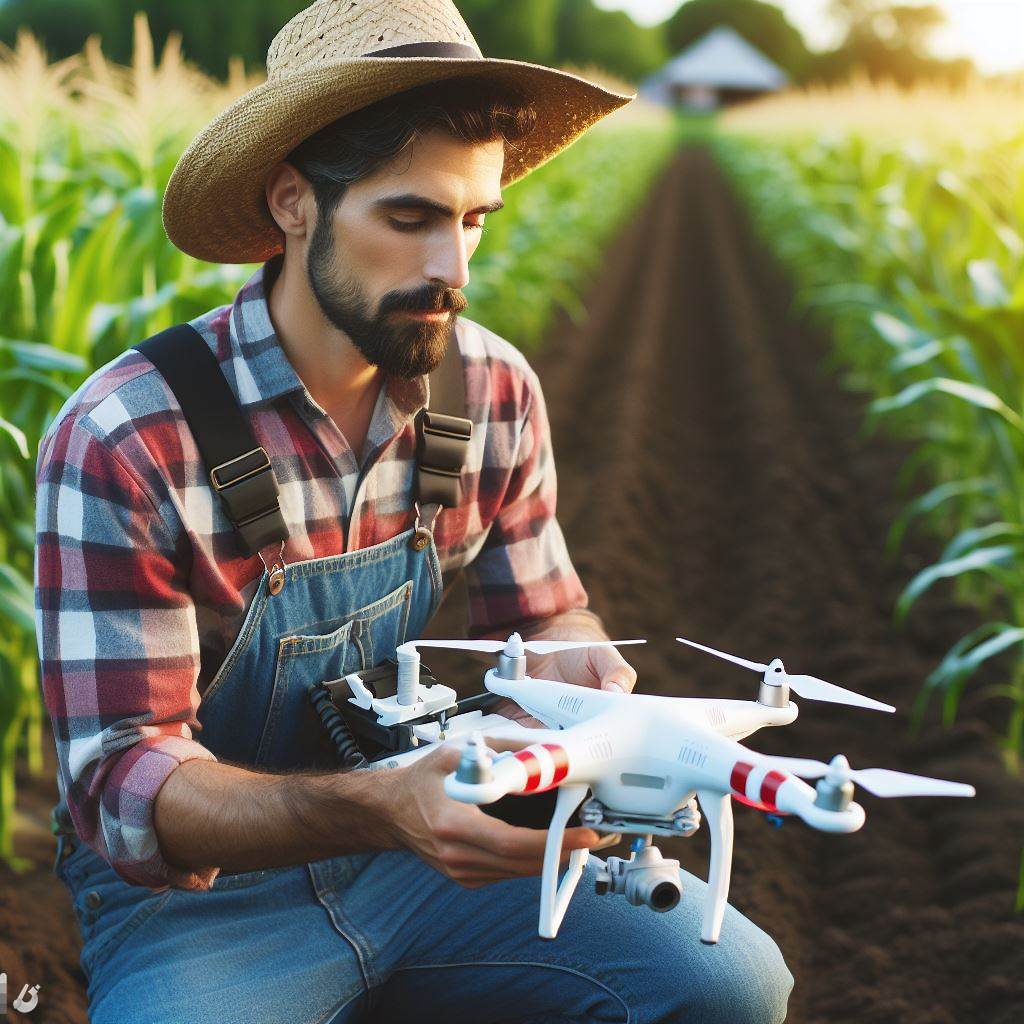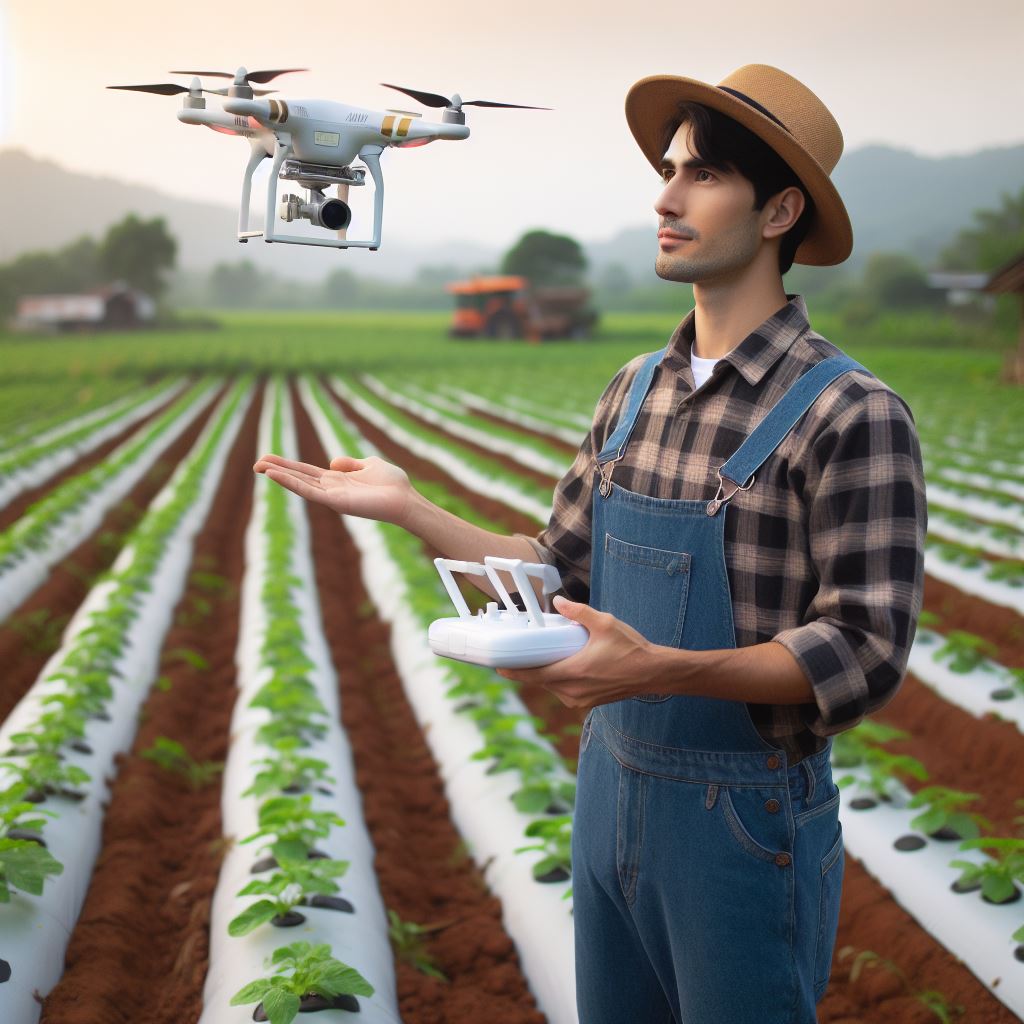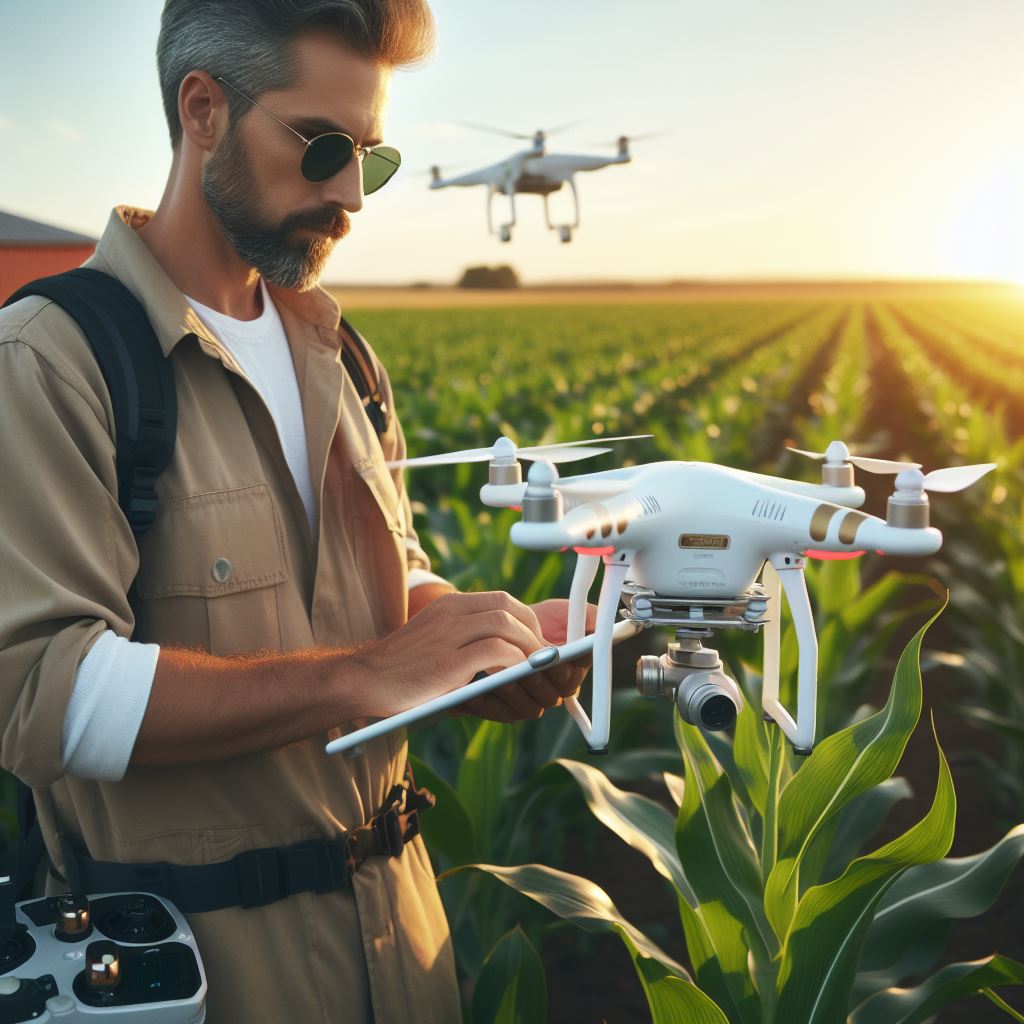Introduction
Agri tech plays a significant role in modern farming by introducing innovative solutions that enhance efficiency and productivity.
One such groundbreaking technology is drone spraying, which has gained attention in the agricultural industry.
Drone spraying is a method that utilizes unmanned aerial vehicles (UAVs) to apply pesticides and fertilizers to crops.
This technology has the potential to transform traditional farming practices by offering numerous advantages.
Benefits of drone spraying
One of the main benefits of drone spraying is its ability to cover large areas of farmland quickly and accurately.
These UAVs are equipped with advanced sensors and GPS systems, enabling precise navigation and targeted spray application.
This eliminates inefficiencies associated with manual spraying, where human error can lead to over or under-application of chemicals.
Another advantage of drone spraying is its cost-effectiveness.
By using drones, farmers can reduce labor costs and optimize their use of resources, such as pesticides and fertilizers.
The drones can be programmed to spray only specific areas that require treatment, ensuring minimal wastage and maximum effectiveness.
Furthermore, drone spraying is a safer alternative for both farmers and the environment.
It minimizes direct exposure to chemicals and reduces the risk of health hazards.
Additionally, by using smaller volumes of chemicals more efficiently, it decreases the overall environmental impact caused by excessive chemical usage.
Basically, drone spraying is an exciting development in agri tech that has the potential to revolutionize modern farming.
Its ability to cover large areas quickly, reduce costs, and minimize environmental impact makes it a highly promising tool for crop protection.
Transform Your Agribusiness
Unlock your farm's potential with expert advice tailored to your needs. Get actionable steps that drive real results.
Get StartedWith further advancements and widespread adoption, drone spraying could become a standard practice in future agricultural operations.
What is drone spraying?
Definition and explanation of drone spraying in the farming industry
In the farming industry, drone spraying refers to the use of unmanned aerial vehicles (UAVs) equipped with sprayers to evenly distribute pesticides, fertilizers, and other agricultural chemicals onto crops.
This advanced technology is revolutionizing traditional crop spraying methods and bringing numerous benefits to farmers.
Drones used for spraying are equipped with tanks that hold the liquid chemicals.
They are fitted with sprayer nozzles that release the chemicals in a controlled manner, ensuring an even distribution across the entire crop area.
The drones are operated remotely, allowing farmers to cover large areas quickly and efficiently.
Benefits and advantages of using drones for spraying crops
- Increased efficiency and productivity: Drone spraying eliminates the need for manual labor, saving farmers valuable time and resources. The drones can cover large areas in a short amount of time, increasing productivity and allowing farmers to focus on other important tasks.
- Precision and accuracy: Unlike traditional methods, drone spraying ensures precise application of chemicals to crops. The sprayers can be programmed to follow specific flight paths, targeting specific areas. This reduces chemical wastage and minimizes the risk of over-spraying or under-spraying.
- Cost-effective: By using drones for spraying, farmers can reduce their overall operational costs. The efficiency of drones allows for a more targeted application of chemicals, reducing the quantity needed. Additionally, the savings on labor costs make drone spraying a cost-effective solution for farmers.
- Safety for farmers and the environment: Drone spraying removes the need for farmers to come into direct contact with potentially harmful chemicals. This reduces the risk of exposure and potential health hazards. Moreover, drones can be equipped with sensors and cameras to monitor the condition of crops, enabling early detection of diseases or pests.
Additional benefits
- Accessibility to difficult terrains: Drones can reach areas that are challenging to access by traditional means, such as steep slopes or uneven terrain. This enables farmers to treat crops in remote or inaccessible locations, improving overall crop health and yield.
- Data collection and analysis: Many drones used for spraying are equipped with advanced sensors and imaging capabilities. This allows farmers to collect valuable data about their crops, such as plant health, growth patterns, and nutrient deficiencies. The data can be analyzed to make informed decisions about crop management and optimize farming practices.
- Sustainability and reduced environmental impact: Drone spraying offers a more sustainable approach to crop protection. The precise application of chemicals minimizes environmental contamination and reduces the impact on nearby ecosystems. Additionally, drones run on electricity, making them a greener alternative to traditional spraying methods that require fuel-powered machinery.
Generally, drone spraying is a game-changing technology in the farming industry.
Its ability to efficiently and accurately distribute chemicals onto crops brings numerous benefits to farmers.
From increased productivity and cost-effectiveness to improved safety and sustainability, drone spraying is revolutionizing agriculture and paving the way for a more efficient and eco-friendly future.
Read: Drones in Agri: Irrigation Game Changer
How does drone spraying work?
Basic functioning of drones in the spraying process
- Drones used in agriculture are equipped with special tanks to carry liquid pesticides or fertilizers.
- These drones are programmed with specific flight paths to ensure accurate and efficient spraying.
- Once in the air, the drones use GPS technology to navigate through the fields.
- They fly low over the crops, releasing the pesticides or fertilizers through nozzles or sprayers.
- The drones are capable of spraying large areas in a relatively short amount of time.
- Using drones for spraying eliminates the need for manual labor and reduces human exposure to chemicals.
- The drones can also be controlled remotely, allowing operators to adjust spraying patterns and quantities as needed.
- After completing the spraying task, the drones return to their base for refueling and maintenance.
The technology and equipment involved
- Drone spraying technology involves advanced sensors, cameras, and GPS systems to ensure accurate spraying.
- The drones are equipped with specialized software that enables automated flight and precise spraying.
- The software also allows operators to monitor the drone’s performance and make real-time adjustments.
- The liquid pesticides or fertilizers are stored in tanks integrated into the drones’ framework.
- Pumps and nozzles connected to the tanks release the chemicals in a controlled manner during flight.
- The drones are powered by efficient and lightweight batteries that provide enough energy for the spraying operation.
- Advanced imaging technology in the drones helps identify areas of the field that require treatment.
- The drones can capture and analyze data, providing valuable insights for crop management and optimization.
Different types of drones used for spraying and their features
The market offers various types of drones specifically designed for agriculture spraying.
Each type has its own unique features and capabilities:
- Fixed Wing Drones: These drones resemble small airplanes and are ideal for large-scale farming due to their long flight endurance and high payload capacities.
- Multi-Rotor Drones: These drones have multiple rotors and are more maneuverable than fixed-wing drones, making them suitable for smaller or irregularly shaped fields.
- Hybrid Drones: These drones combine the advantages of both fixed-wing and multi-rotor drones, providing longer flight times and enhanced versatility.
- Smart Sprayers: Equipped with advanced sensors and artificial intelligence, these drones can autonomously detect and target specific areas for treatment, reducing chemical usage.
- Customized Drones: Some companies offer customized drone solutions tailored to specific crop types, environmental conditions, and spraying requirements.
Essentially, drone spraying is an innovative agricultural technique that offers precise and efficient crop treatment.
The basic functioning involves drones equipped with tanks, GPS navigation, and spraying mechanisms.
The technology and equipment used include advanced sensors, cameras, and software for automated flight and monitoring.
Different types of drones, such as fixed-wing, multi-rotor, hybrid, smart sprayers, and customized drones, cater to various farming needs.
With the ever-evolving advancements, drone spraying continues to revolutionize and optimize modern agriculture practices.
Read: Agri-Drones: Changing the Face of Farming
Advantages of drone spraying
Increased efficiency and precision in spraying operations
Drone spraying technology offers numerous advantages over traditional methods, especially when it comes to efficiency and precision.
The use of drones allows for a more targeted approach in delivering pesticides and fertilizers to crops.
With the ability to fly at a low altitude, drones can precisely target specific areas that need treatment.
This targeted spraying significantly reduces the amount of chemicals used, resulting in cost savings and minimizing any potential environmental impact.
Reduction in manual labor and operational costs
One of the significant advantages of drone spraying is the reduction in manual labor required for spraying operations.
In traditional methods, farmers have to physically walk through the fields with backpack sprayers, which is time-consuming and labor-intensive.
Showcase Your Farming Business
Publish your professional farming services profile on our blog for a one-time fee of $200 and reach a dedicated audience of farmers and agribusiness owners.
Publish Your ProfileBy utilizing drones, farmers can spray their crops remotely, saving both time and effort.
This reduction in manual labor also translates into cost savings by eliminating the need for additional hired labor and associated operational expenses.
Ability to cover larger areas in a shorter duration
Drones are capable of covering larger areas in a shorter duration compared to traditional spraying methods.
With their ability to fly at higher speeds and cover large swaths of land, drones revolutionize the way agricultural spraying is done.
This increased coverage allows farmers to treat their crops more efficiently, ensuring that every square meter receives the necessary treatment.
The speed and agility of drones enable farmers to spray their fields quickly, reducing the overall time required for spraying operations.
Environmental benefits and minimized chemical waste
Another crucial advantage of drone spraying is the environmental benefits it provides.
By precisely targeting specific areas with pesticides and fertilizers, drone spraying minimizes the overall chemical usage.
Traditional methods may result in chemical waste due to overspraying or improper application.
Drones, on the other hand, can apply the exact amount of chemicals needed, reducing waste and potential harm to the environment.
Additionally, drone spraying reduces the risks associated with exposure to harmful chemicals for farmers.
With the use of drones, farmers can maintain a safe distance from the sprayed area, minimizing health hazards.
Furthermore, the precise application of chemicals by drones minimizes the chances of runoff or contamination of nearby water sources.
With traditional methods, there is a higher risk of chemicals reaching lakes, rivers, or groundwater, causing pollution.
In general, drone spraying brings numerous advantages to the world of agriculture.
From increased efficiency and precision to reducing manual labor and operational costs, drones have revolutionized the way farmers spray their crops.
The ability to cover larger areas in a shorter duration and the environmental benefits of minimized chemical waste make drone spraying an indispensable tool in modern agriculture.
Read: Data Analytics in Modern Farming
Challenges and limitations of drone spraying
Weather conditions and flight restrictions
- Drone spraying operations are highly dependent on favorable weather conditions.
- Strong winds, rain, fog, or extreme temperatures can adversely affect the spraying process.
- Unpredictable weather patterns may lead to delayed or canceled spraying missions.
- Flight restrictions during adverse weather conditions ensure the safety of the drones and surrounding areas.
- The inability to fly and spray in unfavorable weather may limit the efficiency and effectiveness of drone spraying.
Limited payload capacity and operational range
- Most drones used for spraying have a limited carrying capacity for pesticides or fertilizers.
- The payload capacity determines the amount of agrochemicals that can be applied per flight.
- Refilling the drone with agrochemicals may be required multiple times for large-scale operations.
- Operational range, influenced by battery life, limits the distance drones can cover in a single flight.
- The need for frequent refueling and reloading can prolong the spraying process and decrease overall efficiency.
Potential risks and safety considerations
- Drone spraying introduces potential risks to human health if not executed with proper safety measures.
- Accidental spray drift may lead to unintended exposure of nearby individuals or environmentally sensitive areas.
- The use of drones in populated areas requires careful adherence to regulations and safety protocols.
- Unauthorized access to drones or their payloads can pose security threats or misuse of agrochemicals.
- Proper training and licensing of drone operators are essential to minimize accidents and ensure safe operations.
Addressing these challenges
Dealing with these challenges and limitations is crucial to fully exploit the potential of drone spraying technology.
By addressing weather conditions and flight restrictions, advancements can be made in enhancing the resilience of drones to adverse weather.
Improvements in drone design can result in increased payload capacity and operational range, reducing the need for frequent refilling and reloading.
To mitigate risks and safety considerations, strict adherence to regulations, safety protocols, and ongoing training are necessary.
Collaboration between regulatory bodies, industry stakeholders, and researchers can further improve the safety and efficiency of drone spraying.
Efforts should be made to develop sensors and technology that can monitor and optimize spraying operations, ensuring accuracy and minimizing environmental impact.
Despite the challenges, drone spraying offers numerous benefits, including increased productivity, reduced labor costs, and precise application of agrochemicals.
Continued research, development, and innovation will further overcome the limitations, making drone spraying a game-changing technology in agriculture.
Read: Sustainable Ag Tech: What’s New?
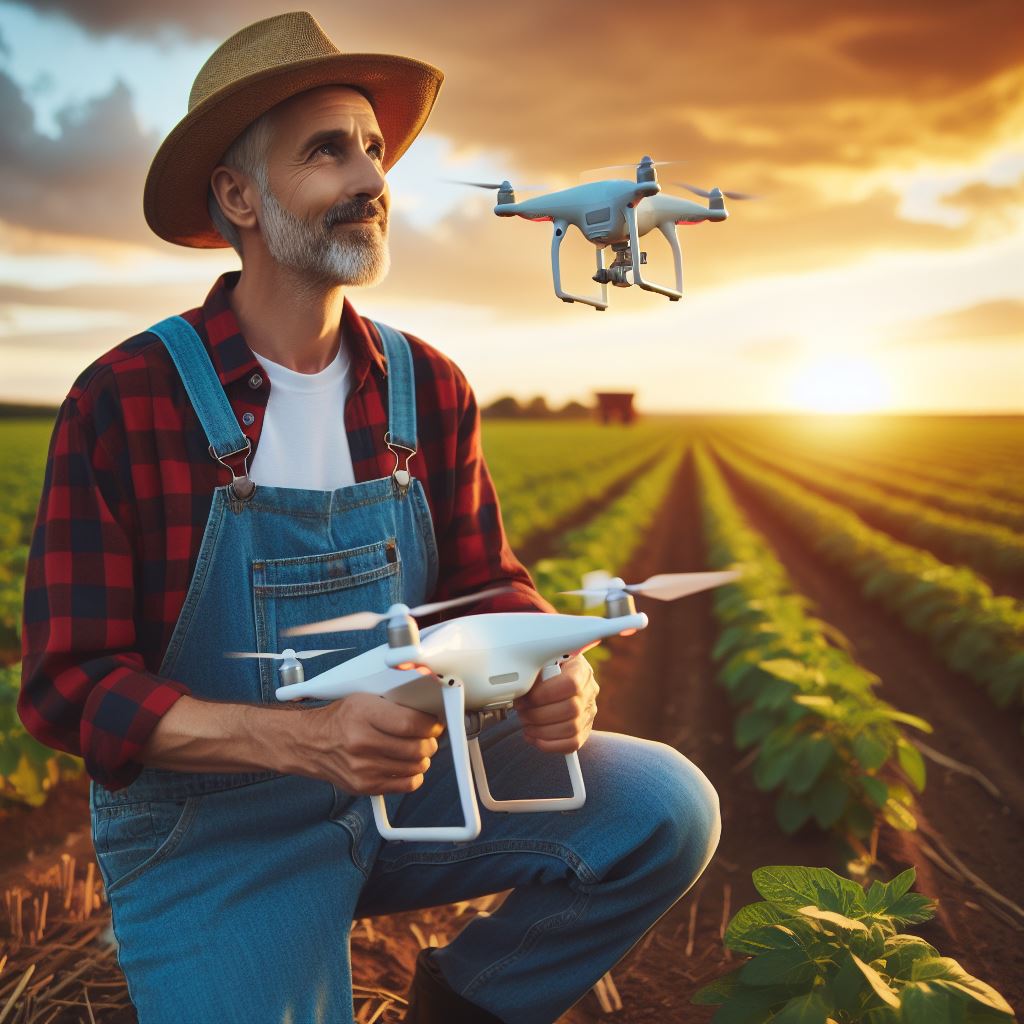
Successful case studies and examples
Successful implementation of drone spraying in different regions
- In China, drone spraying has been successfully utilized in rural areas for pest control.
- Farmers in Australia have adopted drone spraying technology to combat weed infestation.
- Drones have been effectively used for spraying crops in the vineyards of California.
- In Japan, drone spraying has been employed for precision application of fertilizers and pesticides.
Case studies showcasing increased crop yields and reduced resource usage
- In a study conducted in China, drone spraying resulted in a 15% increase in rice yield.
- Farmers in Australia observed a 20% reduction in herbicide usage with the use of drone spraying.
- California vineyards experienced a 10% increase in grape production after implementing drone spraying.
- Japanese farmers reported a 30% decrease in pesticide usage, leading to cost savings and environmental benefits.
These case studies demonstrate the effectiveness of drone spraying in agriculture.
Successful implementation of drone spraying in different regions
By highlighting successful implementation in different regions and showcasing the resulting benefits, it becomes clear why this technology is gaining popularity.
China
In China, where rice is a major crop, drone spraying has proven to be a game-changer for farmers.
By effectively targeting pests with precision spraying, they have achieved significant increases in crop yield.
This not only boosts their income but also contributes to ensuring food security in the country.
Australia
In Australia, weed infestation is a major challenge for farmers.
Traditional methods of weed control can be time-consuming and labor-intensive.
However, with the use of drone sprayers, farmers have been able to cover larger areas in a shorter time and with less effort.
This has led to increased crop yields and reduced reliance on herbicides.
California
In the iconic vineyards of California, drone spraying has revolutionized crop management.
The ability of drones to navigate through the vines and spray precisely has resulted in improved grape production.
This has been particularly beneficial for small-scale vineyard owners who may not have access to expensive spraying equipment.
Japan
Japan is known for its advanced agricultural practices, and drone spraying is no exception.
Showcase Your Farming Business
Publish your professional farming services profile on our blog for a one-time fee of $200 and reach a dedicated audience of farmers and agribusiness owners.
Publish Your ProfileWith strict regulations on pesticide use, farmers have turned to drones for precise and efficient spraying.
Not only does this method minimize pesticide usage, but it also reduces costs and minimizes the impact on the environment.
These case studies highlight the positive impact of drone spraying on crop yields, resource usage, and overall sustainability.
As technology continues to advance, it is expected that more farmers worldwide will embrace this innovative solution for effective agricultural practices.
Regulation and future prospects
Current regulations surrounding drone spraying in agriculture
- The use of drones for spraying in agriculture is regulated by various governmental agencies.
- Some countries have strict regulations in place to ensure safety and prevent misuse of drone spraying technology.
- These regulations often include restrictions on flight altitudes, operating distances, and the required pilot certifications.
- Additionally, there may be guidelines on the types of chemicals that can be sprayed using drones.
- The purpose of these regulations is to minimize risks to human health, the environment, and crop quality.
Potential future advancements and developments in the field
- As technology continues to advance, there are several potential advancements and developments in drone spraying.
- Improvements in sensor technology can lead to more precise spraying, reducing chemical usage and increasing efficiency.
- Integration of artificial intelligence can enable drones to analyze crop health data and adjust spraying patterns in real-time.
- There is also the potential for drones to collaborate and work together, covering larger areas in a shorter amount of time.
- Furthermore, advancements in battery life and charging infrastructure can enhance the overall operational capabilities of drones.
Expectations for widespread adoption and integration of drone spraying technology
- The future prospects for the widespread adoption and integration of drone spraying technology are promising.
- The benefits of increased efficiency, reduced costs, and minimized environmental impact are driving the interest in this technology.
- However, widespread adoption may still depend on addressing certain challenges, such as regulatory hurdles and public acceptance.
- Governments and industry stakeholders need to work together to develop comprehensive regulations that ensure safety and encourage innovation.
- Furthermore, public awareness and education about the benefits of drone spraying technology can help foster its acceptance.
In essence, regulations surrounding drone spraying in agriculture play a crucial role in ensuring safety and minimizing risks.
The future prospects for this technology are promising, with potential advancements in sensor technology, artificial intelligence, and collaboration capabilities.
However, widespread adoption and integration may require addressing regulatory challenges and gaining public acceptance through awareness and education.
As technology continues to progress, drone spraying is expected to revolutionize the agricultural industry, improving efficiency and sustainability.
Conclusion
Key points discussed in the blog post
This blog post discussed the key points of drone spraying in modern agriculture.
Emphasizing its significant role in revolutionizing the industry, drone spraying has proven to be an efficient and effective method of crop protection.
By utilizing advanced technology and precision agriculture techniques, drones have helped farmers increase productivity and reduce the use of chemicals.
The role of drone spraying in revolutionizing modern agriculture
Furthermore, drone spraying offers numerous advantages such as cost-effectiveness and time-efficiency, allowing farmers to cover large areas in a shorter time.
The ability to access remote or difficult-to-reach locations is another benefit, ensuring comprehensive crop protection.
Encouragement for further exploration and research
It is crucial to encourage further exploration and research in the field of agri tech and drone spraying.
Continuous innovation and development would lead to the refinement of existing technologies and the discovery of new applications.
By integrating drone spraying into agricultural practices, farmers can achieve sustainable and environmentally friendly farming methods.
In a nutshell, the use of drones in agriculture has the potential to revolutionize the industry and address various challenges faced by farmers worldwide.
The practical and economic benefits of drone spraying make it a promising technique for the future of agriculture.
Therefore, it is essential to support further studies and advancements in agri tech to maximize the potential of drone spraying and improve global food production.

